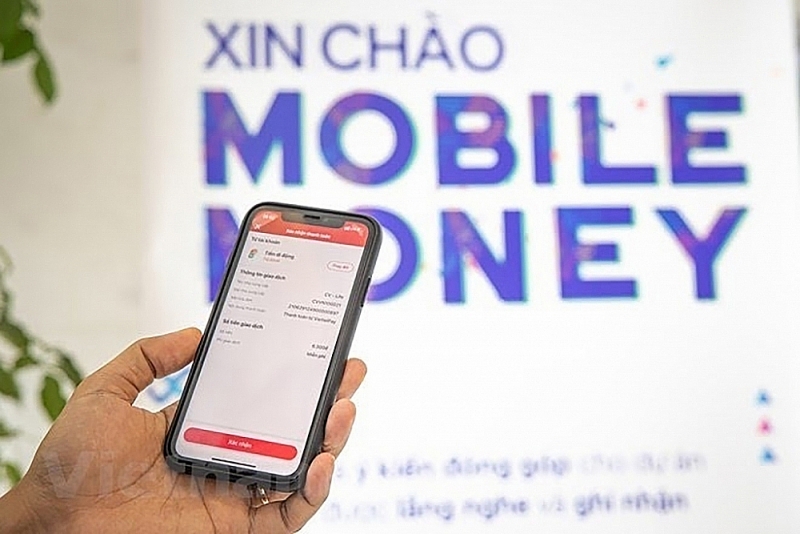 |
| Users still tend to use bank cards in parallel with e-wallets, Mobile Money. Photo: ST |
Barren land and difficult procedures
Vietnam’s payment market has developed significantly with diverse forms, from payments via banks to payments through payment service providers, and telecommunications companies. In which, according to the State Bank, after a half year of pilot implementation, by the end of March 2022 the total number of customers registering and using the service reached more than 1.1 million customers, with more than 3,000 business points and 12,800 payment acceptance units, which are mainly essential services suppliers such as electricity, water, and education. After six months of pilot implementation, the total number of transactions via Mobile Money reached more than 8.5 million transactions but the value was modest, at just over VND370 billion.
For e-wallet services, the Vietnamese market has also experienced rapid development. Currently, there are more than 40 suppliers, which have increased seven times compared to 2015. However, according to statistics on Payoo’s network of food and beverage (F&B) partners, popular payment sources are cards (domestic and international cards), which accounted for 8%, QR codes via e-wallets and banking apps accounted for 15%.
It has also been seen that new forms of payment in Vietnam, especially in paying for low-denomination items, have not been popular yet. According to Pham Minh Tu, Deputy Director of MobiFone digital service center, the “golden time” to deploy Mobile Money has passed, because banks are undergoing a strong digital transformation. Ten years ago, when the number of bank users was small, it was advantageous for telecommunications businesses to provide Mobile Money services. But at this point, according to Tu, opportunities still exist, but this is “barren, rocky land”, because the fertile land have been plowed by banks.
Sharing the same opinion, Nguyen Van Tan, Deputy General Director of VNPT Telecommunications Services Corporation, said that Mobile Money focused on micro payment, that is, customers in remote areas who have little access to banking services. However, the problems lie in how to make it easier for people to access, when management agencies always want to make many regulations on registration procedures, and usage limits. In fact, at VNPT, Tan said that by March 2022, 30% of the total number of customers that registered to use the service has failed because they do not meet the requirements of the management agencies. Causes include; failure due to application of artificial intelligence (AI), big data (Big Data), change of citizen identity, and insufficient time to activate and use the service continuously for at least three months.
Under competitive pressure
According to experts from PwC, Vietnam’s e-wallet market is like to a “tight shirt”. The three leading e-wallets, Momo, Moca, and ZaloPay, account for 90% of the market share, so there is not too much “room” for other suppliers.
Moreover, major e-wallets are facing difficulties as they fail to show their competitive advantage over applications developed by traditional banks that have caught up with e-wallet functions. According to a representative of Sacombank, bank cards are gradually changing positively to match the trend. For example, magnetic cards are replaced by chip cards, applying contactless technology, improving security and information safety.
Along with that, the low limit is a major limitation, creating competition with bank services. According to the regulations of the State Bank, the limit of Mobile Money is VND10 million/month for all withdrawal, money transfer, and payment transactions; the limit of e-wallet is VND100 million/month. In remote areas, payment via Mobile Money or e-wallet is still “unknown” as people do not have enough knowledge and means to do so.
From this issue, experts believed that competitive pressure and market requirements would force payment applications to develop into super apps. Super applications can be created thanks to the close connection between e-wallets and other digital services, such as e-commerce, ride-hailing, delivery, and food delivery. For example, Grab bought 3.5% stake in Moca to link the payment function to this e-wallet; Airpay (now is ShopeePay) sold 30% stake to Sea Ltd, which owns Shopee Vietnam. Additionally, e-wallets cooperate with partners to provide financial services, making it more convenient for customers to use. For example, ZaloPay e-wallet has connected with nearly 270 partners to provide payment services, receive and transfer money.
 | Banks promote lending to exporters amid Việt Nam’s positive shipments |
It can be seen that the low-denomination payment market faces fierce competition. Only the company that provides the best service and has strong financial capacity to “go the long way” will be able to stick around and take advantage of the remaining space. In addition, relevant agencies need to raise people’s awareness about digital payment to expand the domestic market.
